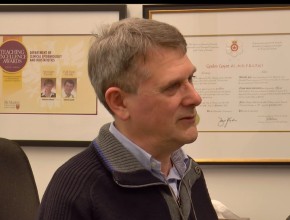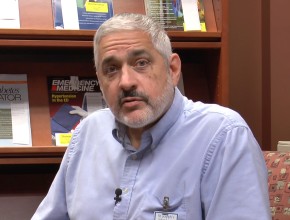References
Recommendations on Breast Cancer Screening. European Commission Initiative on Breast Cancer. http://ecibc.jrc.ec.europa.eu/recommendations/. Accessed July 14, 2017.Roman Jaeschke: Good afternoon. Thank you for joining us for another edition of McMaster Perspective. I would like to introduce to you Professor Holger Schünemann, the chair of the Department of Health, Evidence and Impact at McMaster University, previously known as the Clinical Epidemiology and Biostatistics Department. Today, we are to talk about breast cancer guidelines and maybe my first question would be: how come an epidemiologist and respirologist such as yourself leads the breast cancer guidelines?
Holger Schünemann: The short answer to that question is that as an epidemiologist and clinician who does not focus on breast cancer, I have very little investment in the type of recommendations that would follow in a guideline or that would be the result of a guideline. For me, the most important aspect of developing these guidelines is that the guidelines are consistent with the best evidence and that the recommendations lead to the best outcomes for women. I have no other interests: I have no financial interests in the matter, I have no interest with regards to whether or not I will see more women in my practice to be screened. I just want the best for the population.
Roman Jaeschke: And what you are saying applies to every – what we call – unconflicted methodologist participating in clinical practice guidelines of whatever kind, correct?
Holger Schünemann: It is an evolution that the guideline development community, or world, has seen over the last 10 to 15 years. More emphasis is placed on understanding the evidence, complex research methods, complex numbers, putting them together, and guiding those who have a clinical understanding, or a public health understanding, of how to interpret this information to develop the best possible recommendations.
Roman Jaeschke: And involving patients.
Holger Schünemann: And involving patients, yes.
Roman Jaeschke: Thank you very much for this answer. Could you take us shortly through who asked for these guidelines and to whom those would be applying?
Holger Schünemann: The guidelines were initiated by the European Commission as part of the European Union initiatives. They were initiated because of relatively large differences with regards to how screening is conducted. They were initiated because new thinking has evolved around what age groups should be considered for screening. The guidelines would apply to the member countries of the European Union but could obviously also be used – the way that they are produced – by countries outside of the European Union.
Roman Jaeschke: Because part of these guidelines would be evidence tables describing the consequences of screening.
Holger Schünemann: Yes.
Roman Jaeschke: This is one of the first practice guidelines done in this way. Why breast cancer? How important is this issue?
Holger Schünemann: The issue is extremely important for a number of reasons. One is the frequency of breast cancer in itself. It is correct that probably over lifetime 1 in 10 women may develop breast cancer. The mortality from breast cancer is amongst the highest amongst all cancer mortalities or causes of death for women. It is a very important problem from that point of view, but more importantly, it is possibly one of the cancers that can be detected through screening and the consequences of breast cancer can be mitigated potentially through screening program and appropriate diagnostics.
Roman Jaeschke: You mentioned that there were differences in approaches before and probably will be down the road. Where are they coming from? What kind of outcomes and consequences are people looking at? What can lead to differences in judgments here?
Holger Schünemann: One of the innovations in guideline development, I would say, has been that there is greater emphasis placed on what are the important outcomes for the target population – in this case, women who are at risk of developing breast cancer. The guideline panel, which was a broad panel with representatives from various regions in Europe, with different backgrounds, placed a lot of emphasis or paid a lot of attention to making sure that what the panel would be looking at are outcomes that really matter to women. There were patients’ representatives, Europa Donna for instance, represented on this particular panel to ensure that we are looking at these women-important outcomes.
Roman Jaeschke: What were those?
Holger Schünemann: Those outcomes were, obviously, whether or not breast cancer – if detected – would lead to morbidity, to death. But we also paid a lot of attention to outcomes that are unwanted with regards to when you start screening a population of women, when sometimes a mammogram may suggest that there is a cancer or cancer-like lesion but in reality there is no cancer. We call those false positives.
Roman Jaeschke: How common is that?
Holger Schünemann: They are very common. These numbers may reach up to 24 out of 100 women, so a very large number of women who initially may be a little bit scared because they are called back by the radiologist or by the clinic to undergo further testing. We know from the literature and research that these types of outcomes are important to women. Women do not necessarily want to undergo unnecessary testing down the line and they do not want to be scared and therefore it is important to consider these outcomes, which we did in this panel.
Roman Jaeschke: If you take 100 women and you will be with this population with a high probability of inappropriately positive or falsely positive tests, you will get 20 of them called back. How often does that end up with another radiological test versus, say, biopsy?
Holger Schünemann: Some of this work is currently still being undertaken, looking at what are the best methods when there is a positive finding, or a finding that suggests breast cancer. What would the next steps to follow-up be? Would it be a repeat mammogram? Would it be an ultrasound? Would it be a magnetic resonance imaging (MRI) scan? These types of follow-up tests are currently being evaluated by the committee, but it is clear that in many of these instances biopsies would become [unnecessary] and that women would have to undergo biopsies when actually it is not required, and more importantly, not beneficial.
Roman Jaeschke: Your panel judged all those good things which happen with screening and bad things which may happen with screening, and then mixed them together and came up with recommendations. Could you give us a summary of those?
End of part 1. Part 2 to follow.
 English
English
 Español
Español
 українська
українська







